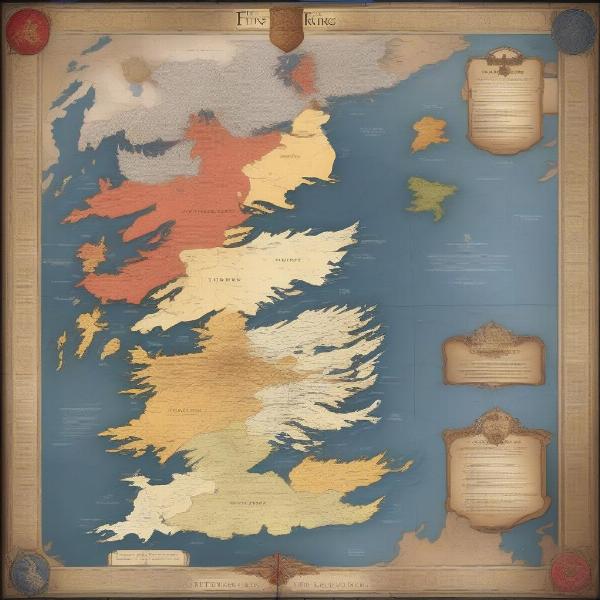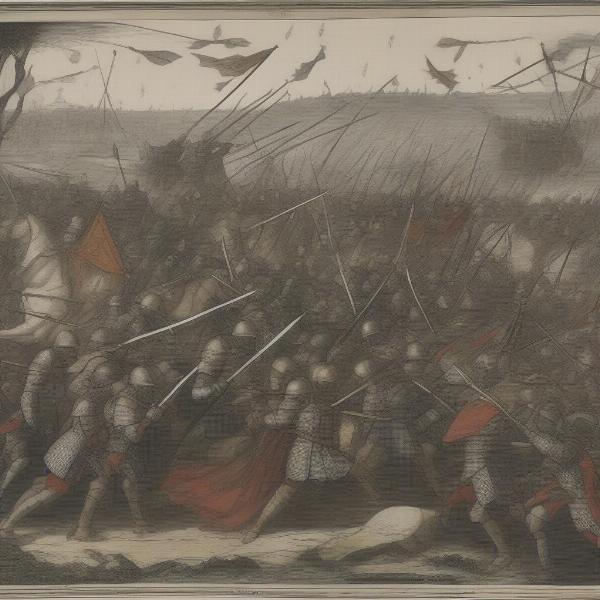The Game Of Thrones War is a central theme throughout George R.R. Martin’s epic saga, and here at Supreme Duelist Blog, we delve into the intricacies of these conflicts. From the brutal battles to the complex political maneuverings, the wars of Westeros are more than just clashes of swords; they are a study in power, ambition, and survival. This article will explore the major conflicts, analyze the strategies employed, and examine the key figures who shaped the destiny of the Seven Kingdoms.
We’ll dissect the motivations behind the major wars and explore how each conflict shaped the future of Westeros. We’ll also look at the real-world historical inspirations behind these fictional battles. Join us as we navigate the treacherous landscape of Westerosi warfare.
The Many Faces of War in Game of Thrones
The wars in Game of Thrones are far from simple clashes of good versus evil. They are a complex web of competing interests, personal vendettas, and desperate struggles for power. Let’s explore some of the key conflicts. One of the most pivotal conflicts is the war of 5 kings game of thrones, which tore the Seven Kingdoms apart after the death of King Robert Baratheon.
The War of the Five Kings: A Descent into Chaos
The War of the Five Kings is a prime example of how fragile power structures can be. With multiple claimants vying for the Iron Throne, the kingdom fractured into warring factions. Each claimant had their own reasons for fighting, creating a chaotic and unpredictable landscape. Stannis Baratheon, Renly Baratheon, Robb Stark, Joffrey Baratheon and Balon Greyjoy all made claims to the throne after Robert’s death and began a war that changed the course of Westeros forever.
- Joffrey Baratheon: The supposed heir to the throne, his legitimacy was constantly challenged leading to constant war.
- Robb Stark: Declared King in the North, he sought independence for his people.
- Stannis Baratheon: A staunch believer in his right to the throne, he fought ruthlessly for what he saw as his birthright.
- Renly Baratheon: Charming and popular, his claim further divided the Baratheon loyalists.
- Balon Greyjoy: Seizing the chaos as an opportunity, the Ironborn rebelled seeking independence from the Iron Throne.
This conflict showcased not only the brutality of war but also the strategic brilliance and tragic flaws of various leaders. To truly understand the landscape of Westeros, you must study the game of thrones war table.
 westeros-war-map
westeros-war-map
The Long Night: A Battle Against the Undead
The threat of the White Walkers and the army of the dead brought a different kind of war to Westeros. This wasn’t a conflict for power, but a fight for survival against an existential threat. The Long Night required a united front, forcing even bitter enemies to forge alliances. The wars in game of thrones showcase a range of battle styles and motivations, but the war against the dead was the only time the realm united under one banner.
“The Long Night taught us that survival isn’t about individual ambition, but collective action,” says Professor Evelyn Reed, a historian specializing in Westerosi history. “The threat from the North forced characters to grow and adapt, pushing them beyond their comfort zones, and making them accept help from unexpected places.”
The battles against the White Walkers highlighted the importance of strategic alliances and unconventional warfare. It also demonstrated the vulnerability of the living in the face of overwhelming odds. The strategies employed were markedly different from the wars between human factions, emphasizing the importance of understanding your enemy and adapting to the situation.
Tactics, Strategy, and Leadership in Westerosi Warfare
The wars of Westeros are not solely decided by brute strength, but by complex tactics, shrewd strategies, and effective leadership.
The Importance of Logistics
In any war, logistics are crucial, and the Game of Thrones universe is no exception. Armies need food, supplies, and reliable supply lines. Successful commanders like Robb Stark understood the need to keep his troops fed and supplied.
The Role of Terrain
The diverse landscapes of Westeros play a significant role in warfare. From the mountains of the Vale to the plains of the Reach, battles were often decided by who knew the terrain best. Knowing how to exploit the natural environment can lead to great victories.
“Terrain is as vital to a victory as any army,” claims General Thomas Blackwood, a military strategist with a focus on medieval warfare. “A clever commander will always use the environment to their advantage, be that a defensive mountain pass or a wide, open plain to charge on.”
Leadership and the Psychology of War
Effective leadership was paramount in Game of Thrones. Commanders like Robb Stark and Daenerys Targaryen inspired loyalty and instilled confidence in their troops. Their ability to motivate and lead their armies was key to their military success. The psychology of war is crucial as a confident army will outperform a frightened one, even if smaller.
Naval Warfare
Naval power was also a critical aspect of the game of thrones war, with the Iron Fleet and various other navies playing vital roles. Control of the seas was vital for trade, supply lines and troop transport. The battles on water were unique and utilized a very different approach to land warfare.
 westeros-battle-scene
westeros-battle-scene
Historical Inspirations: The War of the Roses and Beyond
George R.R. Martin has drawn inspiration from various historical events, most notably the War of the Roses when writing A Song of Ice and Fire.
The Parallels to the War of the Roses
The war of the roses game of thrones has very clear parallels with the events of the Wars of Westeros. The conflict between the House of Lancaster and the House of York mirrors the conflict between the Starks and the Lannisters. The complex web of alliances and betrayals is reflective of the volatile nature of 15th-century English politics.
Other Historical Influences
Beyond the War of the Roses, Martin has incorporated elements of other historical conflicts, like the Hundred Years’ War and various medieval power struggles. The use of different kinds of armies, from knights and infantry to siege engines and archers, adds another layer of historical accuracy to the battles in the books.
The Legacy of War and Its Impact on Westeros
The constant wars of Westeros have had a profound and lasting impact on its society. The loss of life, the destruction of infrastructure, and the social upheaval caused by these conflicts are felt long after the battles are over.
Political Instability
The various wars have left Westeros in a state of perpetual political instability. The constant power struggles between the great houses have made it difficult to establish lasting peace and stability.
Societal Change
The wars also led to societal change, forcing people to confront the realities of war and its impact on their lives. The common folk and even the nobles were affected by the constant war, showing the lasting effects it can have on the realm. The question of who wins the war in game of thrones is complex. Victory comes at a cost, leaving the land forever changed.
Conclusion
The game of thrones war is not simply about battles and bloodshed; it’s about power, politics, and the human condition. From the grand schemes of kings to the desperate struggles of common soldiers, the wars of Westeros are a mirror to our own history. Here at Supreme Duelist Blog, we strive to provide you with detailed analysis and expert insights into these conflicts, offering a deeper appreciation of the epic world created by George R.R. Martin. Explore our site further for more analyses of your favorite games and entertainment.
Leave a Reply